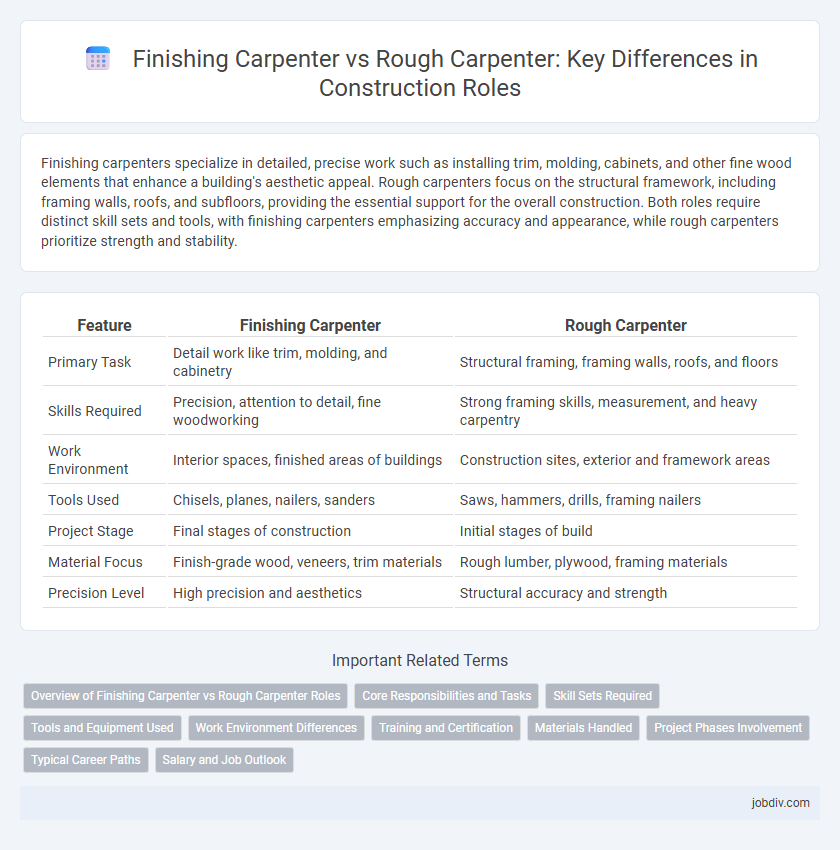Finishing carpenters specialize in detailed, precise work such as installing trim, molding, cabinets, and other fine wood elements that enhance a building's aesthetic appeal. Rough carpenters focus on the structural framework, including framing walls, roofs, and subfloors, providing the essential support for the overall construction. Both roles require distinct skill sets and tools, with finishing carpenters emphasizing accuracy and appearance, while rough carpenters prioritize strength and stability.
Table of Comparison
| Feature | Finishing Carpenter | Rough Carpenter |
|---|---|---|
| Primary Task | Detail work like trim, molding, and cabinetry | Structural framing, framing walls, roofs, and floors |
| Skills Required | Precision, attention to detail, fine woodworking | Strong framing skills, measurement, and heavy carpentry |
| Work Environment | Interior spaces, finished areas of buildings | Construction sites, exterior and framework areas |
| Tools Used | Chisels, planes, nailers, sanders | Saws, hammers, drills, framing nailers |
| Project Stage | Final stages of construction | Initial stages of build |
| Material Focus | Finish-grade wood, veneers, trim materials | Rough lumber, plywood, framing materials |
| Precision Level | High precision and aesthetics | Structural accuracy and strength |
Overview of Finishing Carpenter vs Rough Carpenter Roles
Finishing carpenters specialize in detailed work such as installing trim, molding, cabinetry, and other fine wood elements that enhance the aesthetic appeal of a building. Rough carpenters focus on structural framework, including framing walls, floors, roofs, and formwork that establish the building's foundational integrity. Both roles require distinct skill sets essential for different phases of construction, with finishing carpenters delivering precision and aesthetics while rough carpenters provide strength and support.
Core Responsibilities and Tasks
Finishing carpenters specialize in the detailed installation of trim, molding, cabinetry, and other refined woodwork that enhances a building's aesthetic appeal, focusing on precision and surface quality. Rough carpenters concentrate on structural framework, including framing walls, floors, and roofs, ensuring stability and support during initial construction phases. Their core responsibilities differ fundamentally: finishing carpenters prioritize fine craftsmanship and detail work, while rough carpenters handle the foundational construction tasks essential for a building's integrity.
Skill Sets Required
Finishing carpenters require precision skills in detailed woodwork, including molding, cabinetry, and trim installation, emphasizing accuracy and aesthetic finishing. Rough carpenters focus on structural framing, requiring skills in measuring, cutting, and assembling large wooden frameworks to ensure building stability. Both roles demand knowledge of carpentry tools and safety protocols, but finishing carpenters prioritize fine craftsmanship, while rough carpenters prioritize strength and durability.
Tools and Equipment Used
Finishing carpenters utilize precision tools such as miter saws, nail guns, and chisels to create detailed trim work, cabinetry, and moldings that require smooth, accurate edges. Rough carpenters rely on heavy-duty equipment like circular saws, framing hammers, and power drills designed for framing, roofing, and structural tasks involving large lumber. The difference in tools underscores the finishing carpenter's focus on detail and aesthetics, while the rough carpenter prioritizes strength and efficiency in building frameworks.
Work Environment Differences
Finishing carpenters typically work in controlled indoor environments such as residential homes or commercial buildings, where precision and attention to detail are essential for installing trim, molding, and cabinetry. Rough carpenters operate primarily on construction sites, often outdoors, where they focus on framing, structural components, and building the skeletal framework under variable weather conditions. The differing work environments impact tool selection, safety protocols, and daily workflow, with finishing carpenters requiring fine hand tools and smooth surfaces, while rough carpenters rely on heavy-duty equipment and robust protective gear.
Training and Certification
Finishing carpenters typically undergo specialized training focused on precision skills such as trim installation, cabinetry, and detailed woodworking, often completing apprenticeships or technical courses that emphasize fine craftsmanship. Rough carpenters receive broader training centered on framing, structural components, and basic construction techniques, with certification programs highlighting safety standards and structural integrity. Certification for finishing carpenters often involves proficiency in tools and materials for aesthetic applications, whereas rough carpenter credentials prioritize knowledge of building codes and durable framing practices.
Materials Handled
Finishing carpenters primarily work with fine materials such as hardwoods, trim moldings, and cabinetry components, emphasizing precision and aesthetic detail. Rough carpenters handle structural materials like plywood, framing lumber, and engineered wood products that form the building's skeleton. Both require expertise in wood selection, but finishing carpenters focus on surface treatments and joint fittings, whereas rough carpenters focus on durability and load support.
Project Phases Involvement
Finishing carpenters are primarily involved in the final phases of construction, focusing on detailed tasks such as trim installation, cabinetry, and molding to enhance aesthetic appeal. Rough carpenters engage during the initial project stages, constructing the structural framework, including framing walls, floors, and roofs. Their roles are sequential and complementary, with rough carpentry providing the foundation and finishing carpentry delivering polished interior elements.
Typical Career Paths
Finishing carpenters often progress by specializing in detailed interior work such as cabinetry, trim installation, and custom millwork, eventually moving into roles like project supervisor or interior renovation specialist. Rough carpenters typically advance by gaining expertise in structural framing, formwork, and exterior insulation, with career paths leading to site management, general contractor roles, or specialized trade foreman positions. Both paths may overlap through certifications in safety and advanced carpentry techniques, enabling upward mobility in the construction management field.
Salary and Job Outlook
Finishing carpenters typically earn a higher salary than rough carpenters, with average annual wages ranging from $45,000 to $65,000 compared to $35,000 to $50,000 for rough carpenters. The job outlook for finishing carpenters is projected to grow by 7% over the next decade, driven by increased demand for detailed interior work and renovations. Rough carpenters face steady demand primarily from new construction projects, with employment growth expected to be around 5%, reflecting ongoing infrastructure and housing development.
Finishing Carpenter vs Rough Carpenter Infographic

 jobdiv.com
jobdiv.com